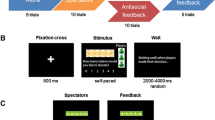Abstract
Sixteen socially isolate preschoolers were classified as peer or non-peer-oriented on the basis of their responses to a test devised to measure the reward value of peers. Half of the subjects in each classification were assigned to a modeling treatment and viewed a film depicting appropriate social behavior in the nursery school; half served as controls and saw an animal film. Peer-oriented modeling film subjects increased significantly more in their peer social interactions at posttest and follow-up assessments than did the non-peer-oriented modeling group. In addition, both peer-oriented and non-peer-oriented modeling groups were significantly higher on peer interaction than the control groups. Alternative and supplemental procedures for increasing isolate preschoolers' social interaction are discussed.
Similar content being viewed by others
References
Allen, K. E., Hart, B. M., Buell, J. S., Harris, F. R., & Wolf, M. M. Effects of social reinforcement on isolate behavior of a nursery school child.Child Development, 1964,35, 511–518.
Bandura, A.Principles of behavior modification. New York: Holt, Rinehart, & Winston, 1969.
Bandura, A., & Menlove, F. L. Factors determining vicarious extinction of avoidance behavior through symbolic modeling.Journal of Personality and Social Psychology, 1968,8, 99–108.
Evers (now Pasquale), W. L., & Schwarz, J. C. Modifying social withdrawal in preschoolers: The effects of filmed modeling and teacher reinforcement.Journal of Abnormal Child Psychology, 1973,1(3), 248–256.
Horowitz, F. D. Incentive value of social stimuli for preschool children.Child Development, 1962,33, 111–116.
MacFarland, J. W., Alien, L., & Honzik, M. P.A developmental study on the behavior problems of normal children between twenty-one months and fourteen years. Berkeley: University of California Press, 1954.
O'Connor, R. D. Modification of social withdrawal through symbolic modeling.Journal of Applied Behavior Analysis, 1969,2, 15–22.
O'Connor, R. D. Relative efficacy of modeling, shaping, and the combined procedures for modification of social withdrawal.Journal of Abnormal Psychology, 1972,79(3), 327–334.
Rotter, J. B.Social learning and clinical psychology. New York: Prentice-Hall, 1954.
VanAlstyne, D., & Hatwick, L. A. A followup of nursery school children.Child Development, 1939,10, 43–72.
Author information
Authors and Affiliations
Additional information
This article is based on the master's thesis of the first author. Gratitude is expressed to Mrs. Millie Blackburn and the staff of the Irwin Methodist Nursery School, Syracuse, New York, for their cooperation during the course of this study.
Rights and permissions
About this article
Cite this article
Evers-Pasquale, W., Sherman, M. The reward value of peers. J Abnorm Child Psychol 3, 179–189 (1975). https://doi.org/10.1007/BF00916749
Revised:
Issue Date:
DOI: https://doi.org/10.1007/BF00916749




